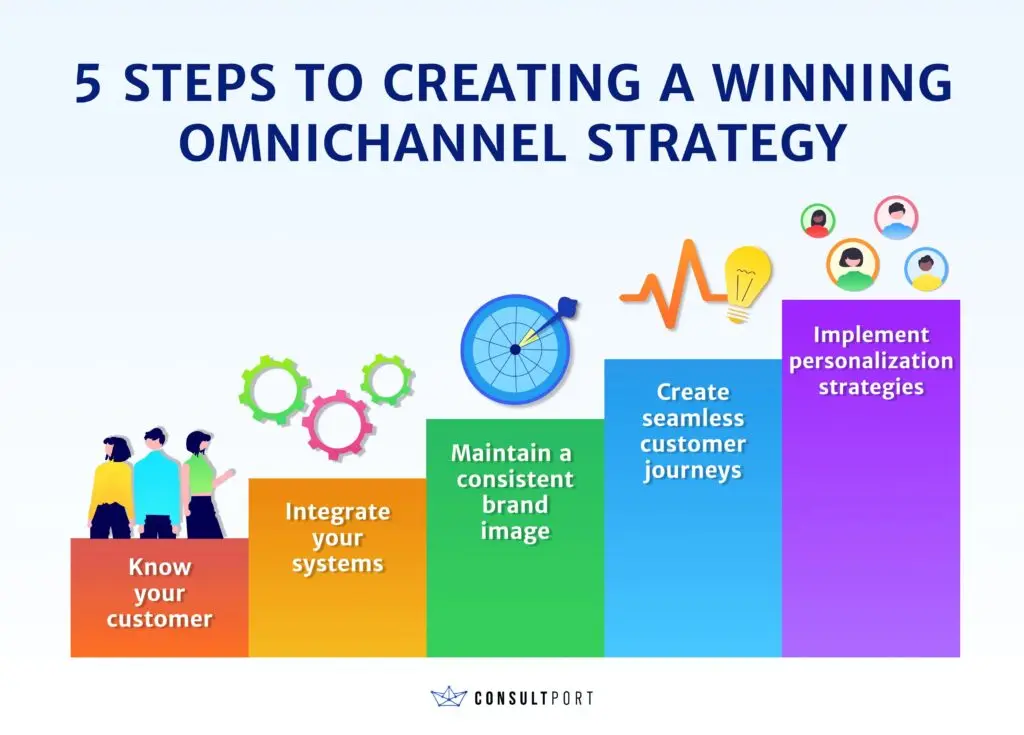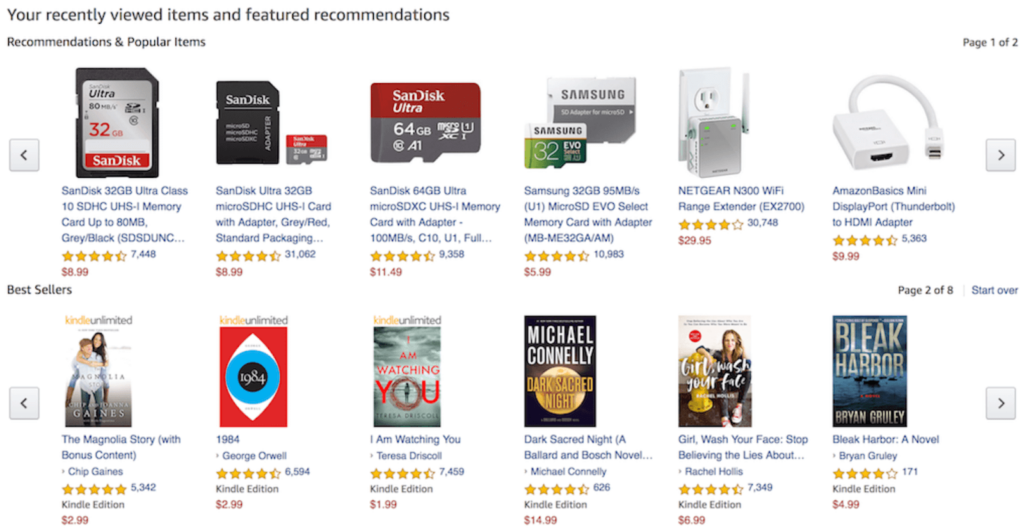5 Steps to Creating a Winning Omnichannel Marketing Strategy
Blog Categories:
Published:
January 29, 2024
Reading Time:
6 minutes

Have you ever wondered how your favorite brands manage to deliver a seamless and interconnected customer experience? It’s like, whether you're browsing their website, engaging on social media, or stepping into their physical store, you feel a sense of connection at every point.
Well, the answer lies in the world of omnichannel marketing. You see, it's not just about reaching customers through various channels—it's about ensuring a unified, user-friendly experience regardless of the platform.
In this article, we’ll discuss what omnichannel marketing is, and how you can create your own strategy to reap its benefits.
So, let’s dive into it.
Well, the answer lies in the world of omnichannel marketing. You see, it's not just about reaching customers through various channels—it's about ensuring a unified, user-friendly experience regardless of the platform.
In this article, we’ll discuss what omnichannel marketing is, and how you can create your own strategy to reap its benefits.
So, let’s dive into it.
KEY TAKEAWAYS
- An omnichannel strategy ensures a consistent experience for customers across online, app, social media, and physical store interactions.
- In the beginning, use surveys, analytics, purchase history, A/B testing, and social media monitoring to understand the target audience.
- A company should maintain consistent language, visuals, and tone across all channels for trust and recognition.
- Omnichannel marketing includes a smooth transition between channels through the use of unified customer profiles, omni-device optimization, and in-store technology.
What Is Omnichannel Marketing?
Picture this scenario: You just spot a fabulous pair of shoes online, but you want to try them on before swiping your card. No problem! With omnichannel magic, you can easily check if they're in stock at the nearby store, stroll in, try them on, and make the purchase. Smooth, right?
Enter omnichannel marketing. Simply put, it's about ensuring that whether your customers are checking out your website, browsing your app, engaging on social media, or walking into your store, the experience is consistent and interconnected. Doesn’t matter if they're on a laptop, smartphone, or stepping into your store—they get a unified, user-friendly experience.
However, you must know the difference between multichannel marketing and omnichannel marketing. Unlike omnichannel, multichannel marketing focuses on reaching customers through various channels but often operates in silos, lacking the seamless integration and coordination that defines omnichannel marketing. In contrast, omnichannel marketing smoothly integrates these channels and provides a singular experience while browsing online, receiving app recommendations, or completing a purchase in-store.


Certainly, you’ve heard of the brand Coca-Cola. Whether you see their advertisements on TV, follow them on social media, visit their website, or purchase their products in-store, you'll notice a consistent brand message—the bright, uplifting red color. The iconic red color and the uplifting tone of their communications remain constant across all channels. This consistency builds a strong brand identity which makes Coca-Cola instantly recognizable and memorable for consumers.
By implementing these strategies, businesses can create a seamless and integrated experience for customers as they navigate through different channels in their journey.

Amazon, the e-commerce giant, exemplifies advanced personalization strategies across its platform. By using customer data, the company tailors its approach across channels. For instance, through personalized email recommendations, customers receive targeted suggestions for new releases or products aligned with their preferences. The website experience is also highly personalized, with the homepage featuring recommendations based on individual browsing and purchase history. Amazing, isn’t it?
Enter omnichannel marketing. Simply put, it's about ensuring that whether your customers are checking out your website, browsing your app, engaging on social media, or walking into your store, the experience is consistent and interconnected. Doesn’t matter if they're on a laptop, smartphone, or stepping into your store—they get a unified, user-friendly experience.
However, you must know the difference between multichannel marketing and omnichannel marketing. Unlike omnichannel, multichannel marketing focuses on reaching customers through various channels but often operates in silos, lacking the seamless integration and coordination that defines omnichannel marketing. In contrast, omnichannel marketing smoothly integrates these channels and provides a singular experience while browsing online, receiving app recommendations, or completing a purchase in-store.
5 Steps to Creating a Winning Omnichannel Strategy
Now that you know what omnichannel marketing is and how it is different from a multichannel strategy, let’s discuss the key steps in creating an omnichannel strategy.
1. Know your customer
You should begin by gaining a deep understanding of your target audience. This can be done in a few different ways. First, identify their preferences, behaviors, and the channels they use to interact with your brand. Then, conduct market research and gather data to create customer personas. This knowledge will be crucial in tailoring your omnichannel strategy to meet the needs and expectations of your audience. Now, let’s discuss some time-tested methods for understanding customers.- Conduct surveys and feedback sessions: Develop surveys to gather direct feedback from your customers. Ask about their preferences, pain points, and what they value in a product or service.
- Utilize website analytics: Leverage website analytics tools to track user behavior on your website to identify popular pages, time spent on the site, and the conversion paths customers take.
- Track purchase history: Keep a record of customer purchase history. Understand the products or services they frequently buy, their average order value, and the frequency of
2. Integrate your systems
To assist your omnichannel strategy, you should invest in technology solutions that allow seamless communication and data sharing between different channels. This integration could involve connecting your customer relationship management (CRM) system, e-commerce platform, social media management tools, and other relevant software. The goal is to have a centralized hub where you can gather and analyze data from various touchpoints. Here are some ways you can integrate various systems:- API integrations: You could utilize application programming interfaces (APIs) to connect different systems and allow them to communicate with each other in real time. Some popular tools for this are Zapier, Tray.io, and Integromat.
- Data synchronization: Ensure that data is synchronized across all systems in real-time or at scheduled intervals to maintain consistency. This can be done through platforms like Microsoft Azure Logic Apps, Informatica, and Talend.
- Cloud-based integration: Leverage cloud-based integration platforms to connect on-premise and cloud-based systems seamlessly. Platforms like Dell Boomi, Azure Logic Apps, and AWS App Integration can do the trick in this case.
3. Maintain a consistent brand image
It’s important to maintain a cohesive brand message across all channels. So, ensure that the language, visuals, and tone of your communication are consistent—whether a customer is engaging with your brand on social media, visiting your website, or interacting in-store. Consistent branding builds trust and helps customers recognize and remember your brand. Let’s consider a real-life example for this one.
(Image: A snip from Coca-Cola’s website with a consistent bright red color across the image.)
Certainly, you’ve heard of the brand Coca-Cola. Whether you see their advertisements on TV, follow them on social media, visit their website, or purchase their products in-store, you'll notice a consistent brand message—the bright, uplifting red color. The iconic red color and the uplifting tone of their communications remain constant across all channels. This consistency builds a strong brand identity which makes Coca-Cola instantly recognizable and memorable for consumers.
4. Create seamless customer journeys
Omnichannel is all about crafting customer journeys that seamlessly transition between different channels. Consider scenarios where a customer might start their journey on social media, move to your website, and then make a purchase in-store. Ensure that these transitions are smooth and customers can pick up where they left off on any channel without any disruptions. This requires careful planning and integration of each touchpoint in the customer journey. So, let’s understand how to do it.- Unified customer profiles: Establish a centralized database that compiles customer data from various touchpoints to ensure a consistent view of customer interactions. This allows for a seamless transition as customers move across channels.
- Omni-device experience: Optimize your website and other digital platforms for a smooth experience across devices. Ensure that the transition from desktop to mobile, for example, is smooth, and allows customers to effortlessly pick up their journey from one device to another.
- In-store technology integration: Integrate technology in physical stores to align with the digital journey. For example, enable customers to access their online shopping history or wish list when they visit a physical store through in-store apps or customer service assistance.
By implementing these strategies, businesses can create a seamless and integrated experience for customers as they navigate through different channels in their journey.
5. Implement personalization strategies
And finally, utilize the data you've collected to personalize customer interactions across channels. So, tailor your marketing messages, product recommendations, and promotions based on individual customer preferences and behaviors. Personalization enhances the customer experience and makes them feel valued. Leverage automation tools to deliver targeted and relevant content to each segment of your audience. Let’s consider an example—Amazon.
(Image: Amazon’s personalized recommendations based on user behavior)
Amazon, the e-commerce giant, exemplifies advanced personalization strategies across its platform. By using customer data, the company tailors its approach across channels. For instance, through personalized email recommendations, customers receive targeted suggestions for new releases or products aligned with their preferences. The website experience is also highly personalized, with the homepage featuring recommendations based on individual browsing and purchase history. Amazing, isn’t it?
How Omnichannel Marketing Experts Can Help
Incorporating an omnichannel strategy isn’t a walk in the park. There are a lot of moving parts and high chances of things going wrong. This is why you should hire omnichannel marketing experts through Consultport. We have over 10,000 consultants in our talent pool and every single one of them has worked with top-tier companies. Here’s what our omnichannel marketing consultants can do for you:
- Marketing channel identification: Let's uncover the array of marketing channels you're using and explore how embracing them as a whole can unlock even greater rewards.
- Consumer journey mapping: Visualize your customer's adventure with your product by mapping every interaction. It's the key to unleashing an omnichannel strategy that embraces every touchpoint.
- Device identification: Dive into the world of your users' devices because knowing how they interact with your product sets the stage for tailored omnichannel magic.
- Technology gap analysis: Take stock of the platforms you’re currently using. Then, our consultants will pinpoint the missing pieces and turn your tech setup into a powerhouse!
Share This Story, Choose Your Platform!




